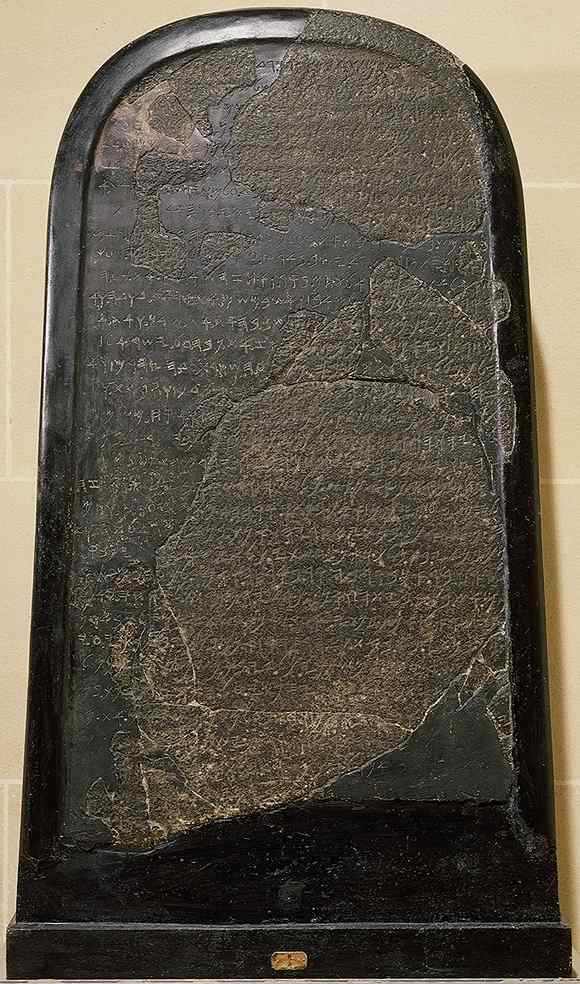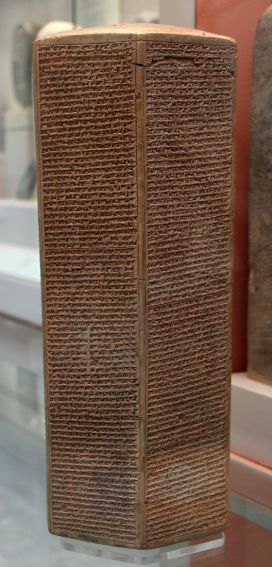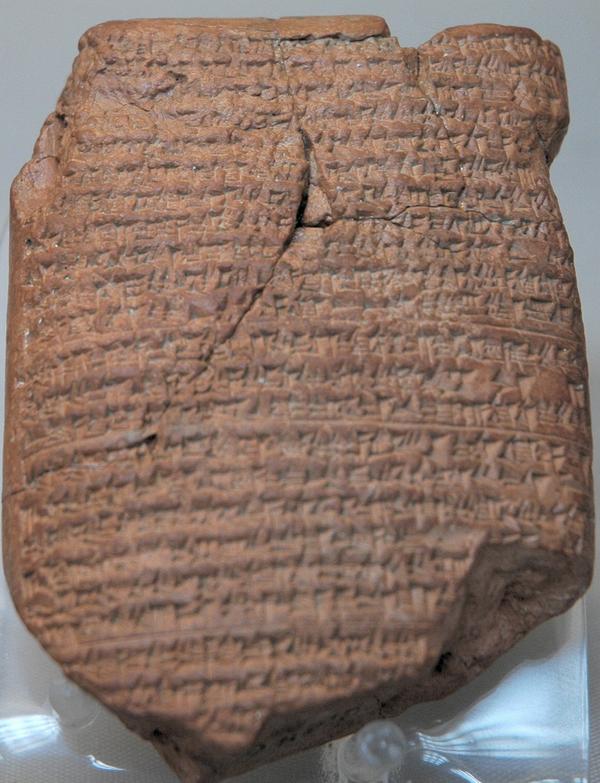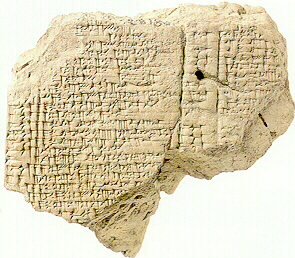REL 433 - Biblical Archaeology
Course Notes and Photos
Modules 11 & 12
Iron Age IIB, The Divided Monarchy, 925-722 BC
Iron Age IIC, Judah alone, 722-587 BC
Images in the text are linked to larger photos - click on them to see the larger pictures.
Hover the mouse over the images to see their captions and copyright credits.
 Foreign Records - Monuments and Documents
Foreign Records - Monuments and Documents
 The Moabite Stele or Moabite Stone was found in 1868 in Transjordan. It is also known as the Mesha Stele because it records King Mesha of Moab's claim of success in gaining independence from Israelite rule (II Kings 3:4-7, 26-27)
The Moabite Stele or Moabite Stone was found in 1868 in Transjordan. It is also known as the Mesha Stele because it records King Mesha of Moab's claim of success in gaining independence from Israelite rule (II Kings 3:4-7, 26-27)
The Kurkh Monoliths
![]() The Kurkh Monoliths were discovered by John George Taylor in 1861 by the River Tigris. They are now in the British Nuseum. They are a pair of Assyrian stelae commemorating the reigns of Ashurnasipal II and his son Shalmaneser III. The Shalmaneser stele describes the Battle of Qarqar, and mentions that Ahab, King of Israel, was one of the kings whom he defeated.
The Kurkh Monoliths were discovered by John George Taylor in 1861 by the River Tigris. They are now in the British Nuseum. They are a pair of Assyrian stelae commemorating the reigns of Ashurnasipal II and his son Shalmaneser III. The Shalmaneser stele describes the Battle of Qarqar, and mentions that Ahab, King of Israel, was one of the kings whom he defeated.
The Black Obelisk of Shalmaneser III

 The Black Obelisk of Shalmaneser commemorates a time when Jehu, king of Israel, paid homage to Shalmaneser III of Assyria.
The Black Obelisk of Shalmaneser commemorates a time when Jehu, king of Israel, paid homage to Shalmaneser III of Assyria.
It names Jehu as the central figure bowing down to the ground before the Assyrian king.
Sennacherib's Prism, the Taylor Prism, and the Jerusalem Prism
![]()
 Sennacherib was so proud of his invasion of Judah and the siege of Jerusalem (II Kings 18:13-19:36) that he had accounts of it engraved on the statues of stone bulls at the entrance to his palace in Nineveh, and also recorded it on clay prisms, three of which still exist (Sennacherib's Prism in the Oriental Institute, Chicago, the Taylor Prism in the British Museum, and the Jerusalem Prism). The Prisms are hexagonal clay pillars covered with cuneiform inscriptions. Colonel R. Taylor acquired the Taylor Prism in Nineveh in 1830, and Henry Layard excavated the bull statues in 1849.
In 1851 Henry Rawlinson published the translation of the text. (compare the Biblical account, II Kings 18:13-19:36)
Sennacherib was so proud of his invasion of Judah and the siege of Jerusalem (II Kings 18:13-19:36) that he had accounts of it engraved on the statues of stone bulls at the entrance to his palace in Nineveh, and also recorded it on clay prisms, three of which still exist (Sennacherib's Prism in the Oriental Institute, Chicago, the Taylor Prism in the British Museum, and the Jerusalem Prism). The Prisms are hexagonal clay pillars covered with cuneiform inscriptions. Colonel R. Taylor acquired the Taylor Prism in Nineveh in 1830, and Henry Layard excavated the bull statues in 1849.
In 1851 Henry Rawlinson published the translation of the text. (compare the Biblical account, II Kings 18:13-19:36)
'As for Hezekiah the Judahite who had not submitted to my yoke, I surrounded 46 of his strong walled towns, and innumerable small places around them, and conquered them by means of earth ramps and siege engines, attack by infantrymen, mining, breaching, and scaling. 200,150 people of all ranks, men and women, horses, mules, donkeys, camels, cattle and sheep without number I brought out and counted as spoil. He himself I shut up in Jerusalem, his royal city, like a bird in a cage. I put watch-posts around him, and made it impossible for anyone to go out of his city. The cities which I had despoiled I cut off from his territory and gave to Mitinti king of Ashdod, Padi king of Ekron, and Sil-Bel king of Gaza, so reducing his realm. I added to their previous annual tax a tribute befitting my lordship, and imposed it on them. Now the fear of my lordly splendour overwhelmed that Hezekiah. The warriors and select troops he had brought in to strengthen his royal city, Jerusalem, did not fight. He had brought after me to Nineveh, my royal city, 30 talents of gold, 800 talents of silver, best antimony, great blocks of red stone, ivory-decorated beds, ivory-decorated chairs, elephant hide, tusks, ebony, box-wood, valuable treasures of every sort, and his daughters, women of his palace, men and women singers. He sent his messenger to pay tribute and do obeisance.'
The Babylonian Chronicle of Nebuchadnezzar
 The Babylonian Chronicle for the reign of Nebuchadnezzar records the Battle of Carchemish, and the accession of Nebuchadnezzar (ca. 605 BC). It then records the attack on Jerusalem, the capture of Jehoiachin, and the appointment of Zedekiah to replace Jehoiachin as king. (II Kings 24:10-17)
The Babylonian Chronicle for the reign of Nebuchadnezzar records the Battle of Carchemish, and the accession of Nebuchadnezzar (ca. 605 BC). It then records the attack on Jerusalem, the capture of Jehoiachin, and the appointment of Zedekiah to replace Jehoiachin as king. (II Kings 24:10-17)
'The King of Akkad moved his army into Hatti-land. He laid siege to the city of Judah, and the King took the city in the second day of the month of Addaru. He appointed a new king to his liking, and carried away great amounts of booty from the city to Babylon.'
Jehoachin's Ration Tablets
 King Jehoiachin, son of King Jehoiakim, was taken as a prisoner to Babylon by Nebuchadnezzar (II Kings 24:8-16, ca. 597 BC) where he was kept as a prisoner until the death of Nebuchadnezzar. After the death of Nebuchadnezzar, succeeding Babylonian kings released Jehoiachin from prison (though they did not allow him to return to Jerusalem) and granted a daily ration of food for him and his five sons. Tablets recording Jehoiachin's rations were discovered in Nebuchadnezzar's palace in Babylon by Robert Koldewey in 1899-1917. They are now in the Pergamon Museum in Berlin.
King Jehoiachin, son of King Jehoiakim, was taken as a prisoner to Babylon by Nebuchadnezzar (II Kings 24:8-16, ca. 597 BC) where he was kept as a prisoner until the death of Nebuchadnezzar. After the death of Nebuchadnezzar, succeeding Babylonian kings released Jehoiachin from prison (though they did not allow him to return to Jerusalem) and granted a daily ration of food for him and his five sons. Tablets recording Jehoiachin's rations were discovered in Nebuchadnezzar's palace in Babylon by Robert Koldewey in 1899-1917. They are now in the Pergamon Museum in Berlin.
![]() Back to Module 11
Back to Module 11
![]() Back to Module 12
Back to Module 12
![]()
Copyright © 2020, Shirley J. Rollinson, all Rights Reserved